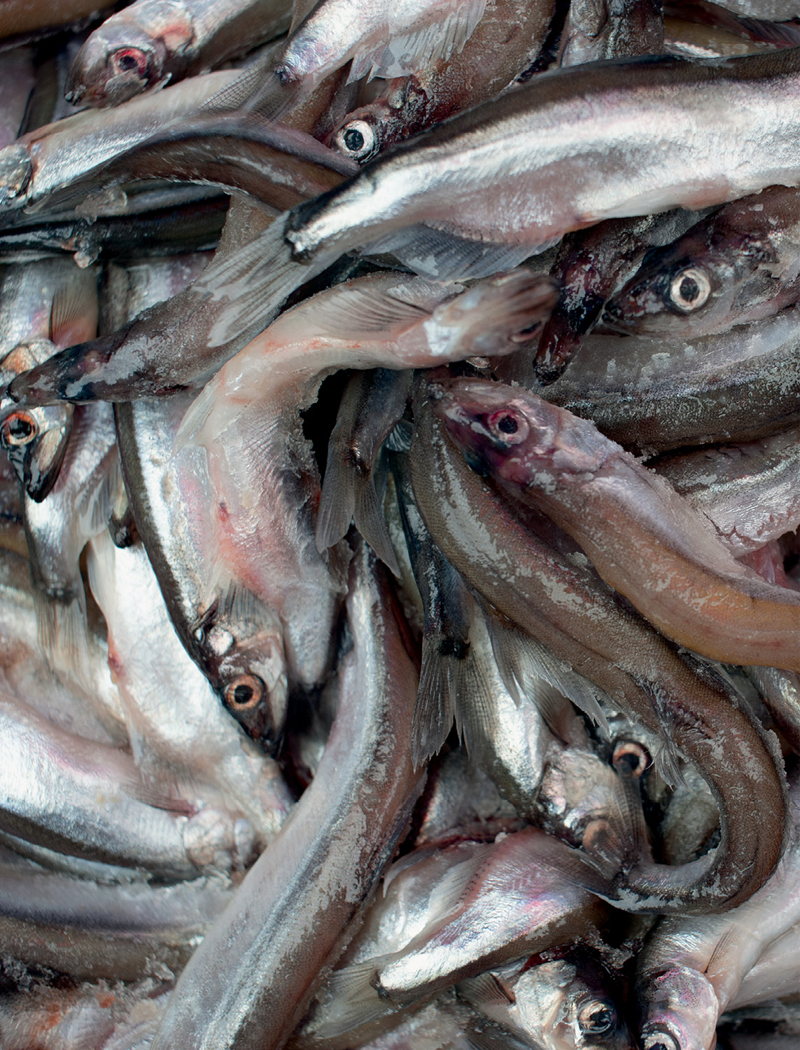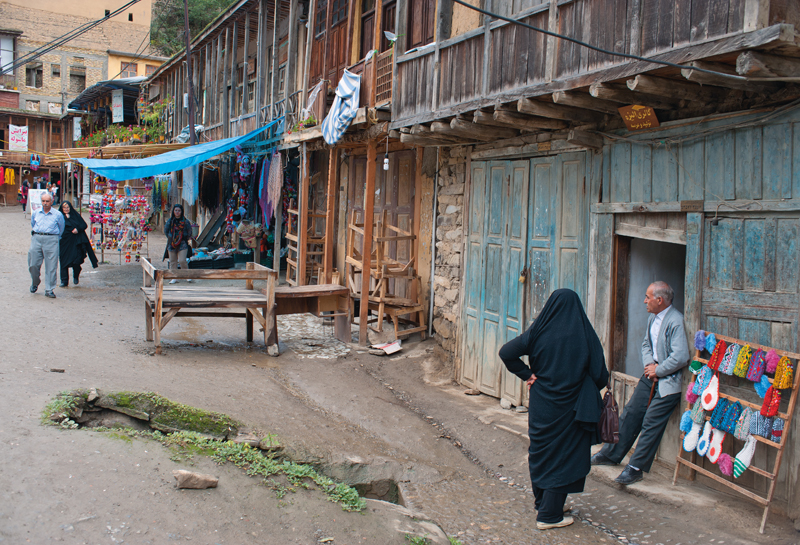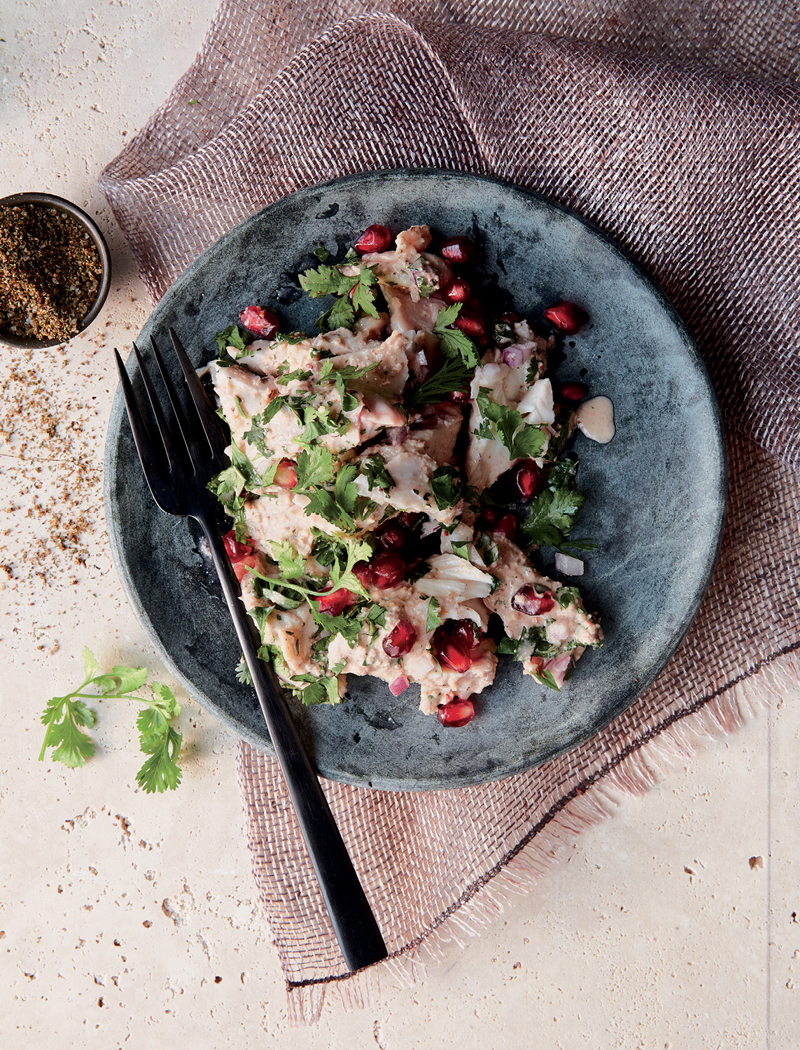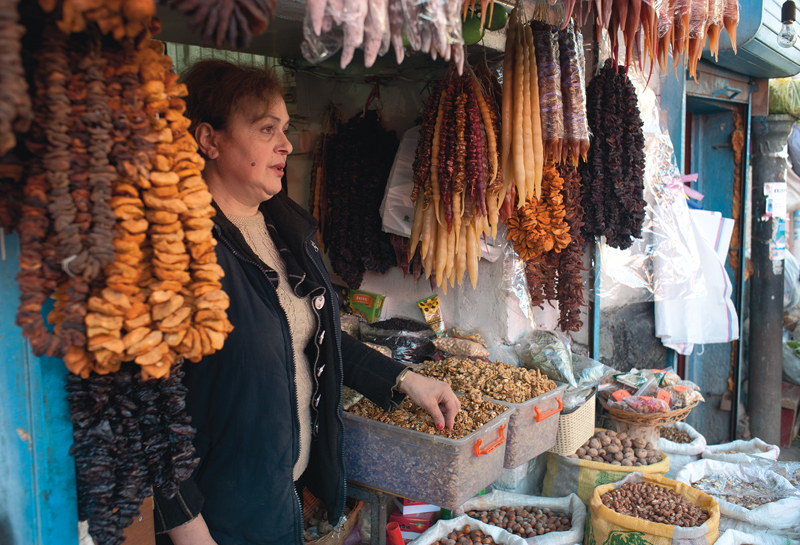

Telavi, eastern Georgia—An abundant jumble of fresh fish at the town market.
Though Iran has a long southern coast on the Gulf of Oman and the Indian Ocean, and a Caspian seacoast too, most Iranians who don’t live on the coast eat very little fish. This probably reflects earlier times, when transporting fresh fish to the cities of the interior was difficult if not impossible. But almost all Iranians do eat fish at Nou-Roz, the New Year that falls at the spring equinox (see Zoroaster’s Legacy).
Perhaps my favorite recipe in this chapter is one I learned in Shiraz from a woman who is from the southern Iranian port city of Bushir, on the Persian Gulf. Whole fish is stuffed with a tamarind-tart dressing, and then fried (see recipe). What could be better? Another whole-fish recipe here comes from Azerbaijan, where it’s called baliq levangi (see recipe). The fish is stuffed with aromatics and then baked loosely sealed in foil so that no moisture or flavor is lost.
Long ago, in 1989, at a restaurant in Tbilisi, I ate sturgeon for the very first time. It came with a seductive pomegranate-walnut sauce, and I was blown away by both the fish and the sauce. But all varieties of sturgeon in both the Caspian and the Black Sea are now endangered and rare. Luckily, North American farmed sturgeon is becoming available, and so it is possible to use it, or salmon or any other rich fish, for another recipe from Azerbaijan, a simple fish kebab (see recipe). The fillets are marinated in lemon juice, threaded on skewers, and then quickly grilled and served with a pomegranate-coriander sauce. I like to serve the simple grilled fillets with Pomegranate-Walnut Sauce to remind me of that long-ago first taste of sturgeon.
This chapter also includes a Georgian fried trout (see recipe), its cavity perfumed with lemon slices, and a lightly spiced fish version of the walnut-sauce-dressed Georgian dish called kuchmachi (see recipe).
At the New Year celebrations of Nou-Roz in Persian households, fried fish is served with Herbed Persian Rice (see recipe). Here fish fillets are seasoned with herbs and spices and then quickly pan-seared. Serve them as a main with a vegetable side such as Spinach Borani (see recipe) and with rice. Or cut into smaller pieces and serve as an appetizer, with some sliced cucumber or leafy greens on the side.
I like freshwater fish, so I use fillets of yellow bass, whitefish, trout, or pickerel. And I prefer skin-on fillets, which cook more evenly and hold together better. If your fillets are large, slice them crosswise into serving-size pieces.
Serve hot or at room temperature, with lemon wedges alongside.
Serves 4 as a main course, 6 as an appetizer
About 1½ pounds fish fillets, preferably skin on
¼ cup all-purpose flour
2 tablespoons powdered dried fenugreek leaves
½ teaspoon cayenne (optional)
¼ teaspoon turmeric
1 teaspoon sea salt
Grinding of black pepper
About 2 tablespoons sunflower or extra-virgin olive oil
1 or 2 lemons, cut into wedges
Rinse the fillets and pat dry. Combine the flour, fenugreek, cayenne, if using, turmeric, salt, and black pepper in a wide shallow bowl and mix together.
Place a wide cast-iron or other heavy skillet over medium-high heat. Add enough oil to just cover the surface of the pan and heat until hot. Place one fillet in the flour mixture and turn it over so that both sides are lightly coated, then carefully lay the fillet in the hot oil, skin side down. Continue to flour the fillets and place them in the oil without crowding; heat and oil a second skillet if necessary, or fry in two batches. After a couple of minutes, use a wide spatula to turn the fillets over; allow each about a minute on the second side. Then turn them back over so they are skin side down and fry until just barely cooked through, another minute or so, depending on the thickness.
Use a slotted spoon or spatula to transfer the fillets to a platter or to individual plates. Serve the lemon wedges alongside.

Caspian shore, Rasht area, Iran—Farahnoz delighted in walking barefoot by the Caspian Sea.
I met two young brothers in a tea shop in the hillside village of Massouleh in northern Iran. They were showing a visiting friend the sights and planned to take her to visit their mother, who lived in a nearby town. There was plenty of room in the car; did I want to come along? When we got to the house, Farahnoz told her sons that we should do a quick jaunt to the seashore. It was a gray and windy day, but never mind, she said, let’s show them the Caspian.
We reached a sandy low-lying stretch of shore that looked a little forlorn in the overcast dull light, with a sagging, closed-for-the-season snack bar and some rough-looking boats pulled up on shore. There were no holidaymakers in sight, just a lone fisherman, who told us how poor the catches were these days, and how hard it was to make a living. We were miles away from the energy and optimism of Tehran, with its crowded freeways, lively bazaars, and high-rise downtown.
We walked along the shore, the waves rippling quietly beside us. Farahnoz took off her shoes and waded barefoot into the sea. There was no one else nearby, so she was free to be barefoot, free to do as she pleased. Her scarf slipping in the wind, she laughed with delight.
And then it was time to go, time for us women to cover our hair, put on our shoes, and return to the public world of constrained behavior.

Massouleh, Iran—A street scene in this tiered hillside village. Cars have to park outside the village, for it has no roads, only steep and unpredictable pathways and steps. In the foreground is an entrance to a staircase that cuts down to another level.
The aromatic stuffing makes this a knockout dish for a special occasion. I learned the recipe from a woman who had moved to Shiraz from the port city of Bushir some years earlier. She’d invited me to lunch, knowing that I wanted to learn more about Persian regional cooking.
There’s a delicious tart flavor in the stuffing, as there is in a lot of Persian dishes. Here it comes from tamarind, an ingredient characteristic of the food of the southern coastal areas of Iran. (Inland and farther north, pomegranate molasses, verjuice, or sour plums give tartness.) The fish is coated in turmeric and rice flour, a reminder that in southern Iran we’re on the trade routes with the Indian subcontinent, where turmeric is always part of fish cookery.
My hostess fried her stuffed fish rather than baking it, because stovetop cooking is much more common than oven-baking in Iran. Like her, I prefer to fry (there’s just more flavor with frying!), but directions for baking the fish are also given below. It is easier to make this with two smaller fish rather than one large one. You will need toothpicks, fine skewers, or a needle and thread for pinning or sewing the fish cavities closed.
Serve the fish hot or warm, with Herbed Persian Rice (see recipe) and a fresh salad, as well as a generous Herb Plate (see recipe).
Serves 4 to 6
1 heaping tablespoon tamarind pulp (1 ounce)
¼ cup hot water
Two 1-pound whole fish (red snapper, for example), cleaned and scaled
1½ teaspoons sea salt
½ teaspoon plus a pinch of turmeric
3 tablespoons rice flour
2 tablespoons sunflower or extra-virgin olive oil, plus about ¼ cup oil for shallow-frying the fish
1 cup minced onion
1 tablespoon minced garlic
2 tablespoons powdered dried fenugreek leaves
½ teaspoon cayenne (optional)
¼ cup chopped fresh coriander, plus ¼ cup coriander sprigs
Tender lettuce leaves or arugula
Cut the tamarind pulp into small pieces and place in a small bowl. Add the hot water. Mix and press the pulp with a fork or spoon so it starts to soften and give off flavor. Set aside to soak for 10 minutes.
Rinse the fish and pat dry. Trim off the fins and discard. Rub inside and out with 1 teaspoon of the salt. Mix together the ½ teaspoon turmeric and the rice flour and put on a wide plate. Dredge the fish in the mixture, turning to coat, and rub some in the cavities too. Set aside on a clean plate.
Press the tamarind pulp and liquid through a sieve into a bowl, using the back of a spoon to extract as much flavor as possible from the pulp. Discard the solids and set the liquid aside.
Heat a heavy wide skillet over medium-high heat. Add the 2 tablespoons oil, and when it is hot, toss in the pinch of turmeric and then the onion. Lower the heat to medium and cook, stirring, until the onion is softened and translucent, 4 to 5 minutes. Lower the heat to medium-low, add the garlic, and cook for about 30 seconds. Add the fenugreek, cayenne, if using, and the remaining ½ teaspoon salt and stir to incorporate. Add the tamarind liquid and cook, stirring, for about a minute. Remove from the heat and set aside to cool for 5 minutes.
Stir the chopped coriander into the onion mixture. Spoon it into the cavities of the fish. Use a needle and thread to sew the cavities closed, or pin the cavities closed with toothpicks or fine skewers.
Place a large plate or long platter by your stovetop. Line it with tender greens if you like.
Place two large skillets over low heat. Add oil to a depth of a scant ¼ inch, raise the heat to medium-high, and wait until the oil is hot. Carefully slide the fish into the oil (it’s okay if the tails hang over the edge) and fry for 5 minutes or so, until crisped and firm on the first side. Use tongs and a wide spatula to carefully turn the fish over. Fry until browned and a little blistered on the second side. Transfer the fish to the plate or platter. Serve hot or at room temperature, sprinkled with the coriander sprigs.
Proceed as for the main recipe, but omit the turmeric–rice flour coating. Once you have soaked the tamarind, mix ¼ teaspoon turmeric with the salt and rub the mixture over the fish, inside and out. Prepare the stuffing as above and set aside to cool.
Place a rack in the center of the oven and preheat the oven to 400°F.
Place two large sheets of aluminum foil (double the length of the fish) on a rimmed baking sheet. Place one fish on each sheet.
Spoon the stuffing into the cavities of the fish. Cover each fish loosely with the foil, creating a tent for it to steam in, rather than wrapping it tightly, and crimp the edges to seal.
Place the baking sheet in the oven and bake for 30 minutes. Remove the pan from the oven and open the foil, being careful not to burn yourself with the steam. The fish should yield to the touch; if they are still firm, reseal their foil tents, return to the oven, and cook for another 10 minutes before testing again.

Lahich, Azerbaijan—Houses here are built almost entirely of stone, and so are the lanes. Most transport is on foot or horseback, but occasionally a car bumps uncomfortably along.
If you have access to trout or to other freshwater fish, such as pickerel, make this fresh-tasting Georgian version of fried fish. Cornmeal gives it a crisp coating, and slices of lemon and sprigs of coriander or tarragon in the cavity of the fish perfume it as it cooks. Serve with boiled new potatoes and a tomato salad or vegetable dish.
Serves 2 to 4
1 whole medium-small trout or other freshwater fish (1 to 1½ pounds), cleaned and scaled
2 to 3 tablespoons sunflower or extra-virgin olive oil
1 teaspoon sea salt
1 lemon, thinly sliced
4 or 5 fresh coriander or tarragon sprigs
About 2 tablespoons cornmeal
Svanetian Salt (see recipe) or Green Ajika (see recipe)
Rinse the fish. Rub the cavity with a little of the oil and ½ teaspoon of the salt. Tuck the slices of lemon inside the cavity and add the herb sprigs.
Place the cornmeal in a wide shallow bowl. Add the remaining ½ teaspoon salt and mix together. Dredge the fish in the cornmeal, turning to coat on all sides.
Place a large heavy skillet over medium-high heat. It should be wide enough to hold the fish comfortably; if the head and tail ride up the sides or even hang over the edge, don’t worry, but you want the body of the fish to lie flat in the pan. Add enough oil to cover the bottom of the pan completely, and when it is hot, carefully slide the fish into the oil. Fry for 5 minutes or until well browned and a little crisp on the first side. Using one or two wide spatulas, carefully turn the fish over and fry for another 5 minutes, or until just cooked through (the flesh inside the cavity should be opaque rather than shiny).
Serve with Svanetian salt or ajika as a condiment.

Kuchmachi is a Georgian dish that’s most often made of simmered chicken or beef or lamb, a kind of meat salad dressed with a savory rich walnut sauce (see Chicken Giblets in Spiced Walnut Dressing) and served at room temperature. This version is made with poached fish.
I first tasted a version of fish kuchmachi at a Palm Sunday fasting feast in Akhalkalaki hosted by the Bishop of Javakheti. The guests, most of whom were keeping the Lenten fast (no animal products except for a few days when fish is permitted), were happy to be able to eat fish on this special day. Outside, the landscape was spare and beautiful, with snowcapped peaks on the horizon. Not far away lay the borders with Turkey and Armenia.
Serve this on a hot day as a main course with an assortment of salads, or serve it as one course in a winter feast, preceded by a clear soup and followed by roast meat or roast vegetables.
Serves 6
2 or 3 bay leaves
5 medium garlic cloves, or to taste
About 3 pounds whole white-fleshed fish (1 large or 2 smaller fish), cleaned and scaled, or 2 pounds fish fillets (see Note on Fish)
2 cups walnuts or walnut pieces
2 tablespoons white wine vinegar
1 teaspoon ground coriander (see Note)
1 teaspoon ground blue fenugreek, or 1 teaspoon powdered dried fenugreek leaves plus ½ teaspoon ground fenugreek (see Note)
1 teaspoon powdered dried marigold petals (optional; see Glossary)
½ teaspoon powdered dried red chiles (see Note)
½ teaspoon dried summer savory or thyme
1 teaspoon sea salt, or to taste
About 1 cup pomegranate seeds (optional)
1 small red onion or 2 shallots, minced (about ½ cup)
½ cup coarsely chopped fresh coriander or dill
Pour ½ inch of water into a wide heavy skillet. Add the bay leaves and 3 of the garlic cloves and bring to just below a boil over medium heat. Slide in the fish, cover, reduce the heat, and poach until the fish is barely cooked through, 5 to 10 minutes, depending on thickness, turning it after 4 minutes. Remove the fish from the water and set aside on a plate to cool. Reserve the cooking broth.
If using whole fish, pull the flesh off the bones and discard the bones and skin. Separate the flesh (from whole fish or fillets) into bite-size pieces, using your fingers or a knife. Set aside in a bowl.
Grind the walnuts to a fine powder in a food processor or in a large mortar. Mash the remaining 2 garlic cloves to a paste. Place the walnuts and garlic in a bowl, add the vinegar and about ¼ cup of the reserved cooking broth, and whisk until smooth. Add the coriander, fenugreek, marigold petals, chiles (or substitute Georgian spice blend; see Note), summer savory, and salt and whisk again. The sauce should be pourable; if necessary, add a little more fish broth.
Pour the sauce over the fish and toss gently to coat it with dressing. If you have the pomegranate seeds, add them, reserving a few for garnish, and mix gently. Let the salad stand for 10 minutes, or as long as an hour, before serving to give the flavors time to blend.
Just before serving, add the minced onion or shallots and the fresh herbs and toss gently to mix well. Taste and adjust the seasoning if necessary. Transfer to a platter or wide shallow bowl and sprinkle on the reserved pomegranate seeds, if using.
Note on Fish: Fish you might use include black sea bass, striped bass, or snapper.
Note: If you have Georgian spice blend, either homemade (see recipe) or store-bought (see Glossary), use 1 tablespoon of the blend instead of the coriander, fenugreek, and chiles.

Tbilisi, Georgia—A dried-fruit seller with garlands of dried apple and dried apricot, boxes of fresh walnuts and hazelnuts, and lots of churchkhela (nuts coated with dried fruit; see here).
This Azeri version of baked stuffed fish is filled with a rich paste, called levangi, of ground walnuts, minced onion, and tart dried fruit.
Serve with rice, Onion Salad with Barberries (see recipe), and a vegetable dish such as Beet Pkhali (see recipe).
Serves 6
About 2 tablespoons sunflower or extra-virgin olive oil
1 cup chopped onion
1½ cups walnuts or walnut pieces
¼ cup chopped sour fruit leather, homemade (see recipe) or store-bought, or sour plums or dried apricots, soaked in water for 15 minutes and drained
About 1½ teaspoons sea salt
1 tablespoon fresh lemon juice
Two 1½-pound whole fish, cleaned and scaled
Place a rack in the center of the oven and preheat the oven to 400°F.
Place a heavy skillet over medium-high heat. Add about 1 tablespoon of the oil and then the chopped onion, lower the heat to medium, and cook, stirring occasionally, until the onion is softened, about 5 minutes. Remove from the heat.
Grind the walnuts finely in a food processor. Add the onion, dried fruit, and ½ teaspoon salt and pulse to blend to a paste. Add the lemon juice and pulse again. Transfer to a bowl and set aside.
Place two large sheets of aluminum foil (double the length of the fish) on a rimmed baking sheet. Wash and dry the fish. Place one fish on each sheet of foil. Rub a little oil over each fish and in the cavities. Rub about ½ teaspoon salt in each cavity, then stuff with the paste. Cover the fish very loosely with the foil, creating a tent for it to steam in, and crimp the edges to seal.
Place the baking sheet in the oven and bake for 30 minutes. Remove the pan from the oven and open the foil, being careful not to burn yourself with the steam. The fish should yield to the touch; if they are still firm, reseal their foil tents, return to the oven, and cook for another 10 minutes before testing again. Serve hot or at room temperature.

Baku, Azerbaijan—A view of the city from the south, with the busy harbor in the foreground, and a huge Azeri flag.
Less than a year after I was first at the shore of the Caspian Sea in Iran (see Caspian Interlude), I saw it again, this time when I was in the bustling city of Baku, capital of Azerbaijan. What a difference context makes. Baku gleams with affluence, at least in the central city. The tidy cobbled streets of the restored old city have a sheen to them, and so does the high fashion in the shop windows along the Bulevar, the main shopping street, which overlooks the shore. Flashy European cars race along the streets at terrifying speeds. New buildings break the horizon with their self-consciously architected shapes: the Flame Towers high on a hill, the rolled-carpet cylinder of the Rug Museum. And the grand buildings from an earlier era have been restored and given back their elegance.
It’s only when you go farther afield, to the lively, earthy Taza food market, for example (see photo), that you see how large the gap is between Caspian oil affluence and the life of most working-class Azeris. And once I left the city, I felt I was in an entirely different world, back in Soviet times in some ways, for not much seems to have changed since then in the Azeri countryside and villages. The public transport between towns is old run-down vans or rackety buses. Some people had cars, but many were still herding flocks of sheep and goats on foot or on horseback, and generally using horses to get around. There was a self-sufficiency in people’s way of life. And there was a warmth in my encounters that was worlds away from the moneyed glossy surfaces of Baku.

The Caspian at dawn, seen from a rooftop in the old city.
Baku Fish Kebabs with Pomegranate-Coriander Sauce (see recipe).
Although sturgeon from the Caspian Sea is the classic and most highly regarded fish in Azerbaijan, you can use any firm, rich fish for these kebabs. The chunks of fish marinate briefly in a blend of lemon juice, salt, and dill before being threaded onto skewers and grilled. They make a great summer meal.
Serves 4 to 6
2 pounds skin-on fish fillets: sturgeon or other rich fish, such as salmon or Alaskan black cod
About ¼ cup fresh lemon juice (from 2 lemons)
About 2 tablespoons minced fresh dill
1 teaspoon sea salt
1 tablespoon sunflower or extra-virgin olive oil
2 medium red onions, thinly sliced
2 medium tomatoes, sliced (optional)
¼ cup minced scallions (optional)
1 tablespoon ground sumac, or to taste
1 cup Pomegranate-Coriander Sauce (see recipe) or wedges of lemon
Herb Plate (see recipe)
Cut the fillets crosswise into pieces about 1½ inches wide. Place in a bowl. Add the lemon juice, dill, and ½ teaspoon of the salt and mix gently to coat the fish. Add the oil and mix again. Set aside to marinate for 30 minutes to an hour.
Preheat a charcoal or gas grill to medium hot and place a rack about 5 inches above the coals or flame.
Thread the fillets onto skewers. It’s easiest to use two skewers in parallel to hold the fish: Pierce 2 or 3 pieces of fish with one skewer, not through the center, but close to one end; then pierce the other end of the pieces with a second skewer, so the arrangement looks like a ladder with fish rungs. Make sure the skin side of all the pieces is facing the same way. Set aside on a tray and repeat with the remaining fish.
Place the skewers skin side down on the rack over the coals or flame and grill for 10 minutes. Turn over and grill until the fish is just cooked, another 4 minutes or so.
Cover a platter with the sliced onions and the sliced tomatoes, if using. Slide the fish off the skewers onto the platter. Sprinkle the remaining ½ teaspoon salt, the scallions, if using, and sumac over the fish, and serve with the accompaniments.
Thanks to advice from friends, I now grill fish fillets skin side down only. The other side steam-cooks a little once the grill lid is closed. Here it picks up delicate flavor from fresh tarragon. Serve the fish with Georgian-style pomegranate sauce and, if you like, green ajika.
Serves 6
Sunflower or extra-virgin olive oil for brushing
About 2½ pounds skin-on sturgeon or trout or other fish fillets
About 1½ teaspoons sea salt
Leaves from about 10 sprigs fresh tarragon, coarsely chopped, or substitute chopped fresh mint
Pomegranate-Walnut Sauce (recipe follows)
Green Ajika (see recipe; optional)
A plate of fresh herb sprigs: chervil, dill, and flat-leaf parsley are all good options
Preheat a charcoal or gas grill to moderate heat.
Brush a little oil on the fillets and rub on the salt. Place skin side down on the grill and top with the herbs, pressing them gently onto the fish. Close the lid and cook until just done, 15 to 20 minutes; the flesh on the top surface will be opaque rather than shiny and the fish will yield to the pressure of a finger, rather than feeling firm and resistant.
Transfer the fish to a platter or individual plates. Put out a small bowl of the sauce, as well as the ajika if you wish, and the herbs.
Place ½ cup pomegranate molasses in a small saucepan, add ½ cup water, stir to mix, and bring to a boil. Lower the heat and simmer for 5 minutes. Meanwhile, place 1 cup walnut pieces and a garlic clove in a food processor or a mortar and process or pound to a paste. Blend the walnut paste into the pomegranate liquid and add ½ teaspoon salt. Taste and adjust the seasoning if necessary. Remove from the heat and stir in some torn fresh coriander leaves.